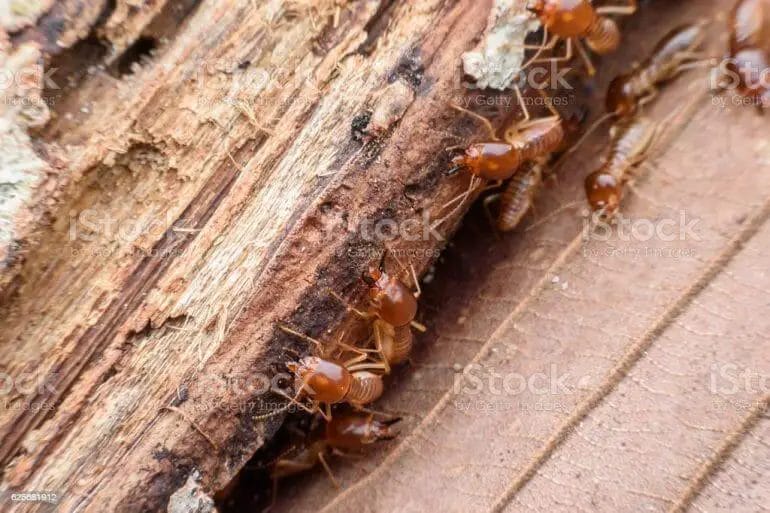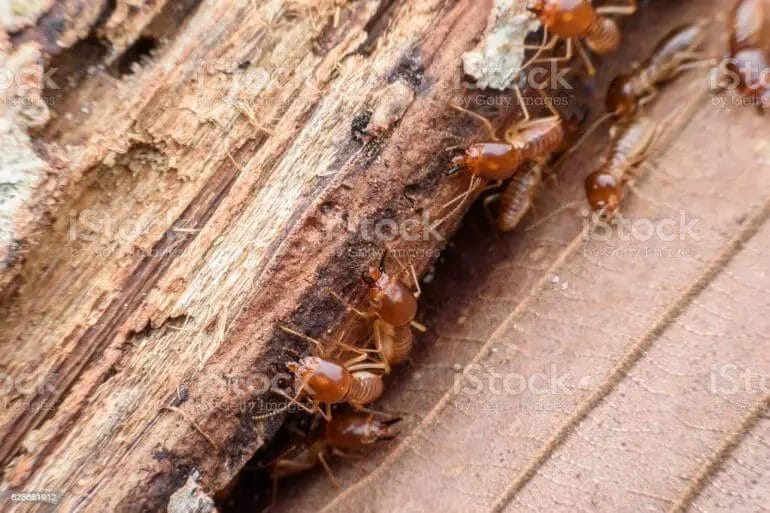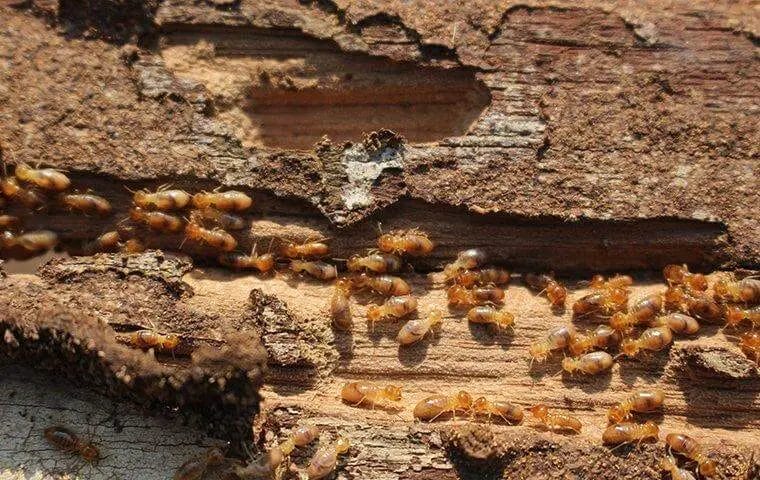Termites are known for their insatiable appetite for wood, but have you ever wondered why they eat it? The answer lies in their unique digestive system and the nutritional value of wood. Termites possess specialized microorganisms in their guts that break down cellulose, the main component of wood, into nutrients they can digest. This allows them to extract energy and nutrients from this abundant resource. Furthermore, termites play a crucial role in the ecosystem by decomposing dead wood and recycling nutrients back into the soil.

Understanding the Biology of Termites: Why Wood is their Primary Food Source
Termites, often referred to as the silent destroyers, are tiny insects that typically feed on wood and other cellulose-based materials. But have you ever wondered why wood is their primary food source? In this section, we will delve into the biology of termites and explore the reasons behind their preference for wood.

Anatomy and Digestive System of Termites
Termites belong to the order Isoptera and are social insects that live in colonies. Within a termite colony, there are different castes, including workers, soldiers, and reproductives. Each caste has its specific role in the colony, and the workers are responsible for gathering food.
The unique digestive system of termites enables them to break down cellulose, the main component of wood. Termites have special microorganisms, such as bacteria and protozoa, living in their hindgut. These microorganisms produce enzymes that can digest cellulose, which is otherwise indigestible by the termites themselves.
Cellulose: A Rich and Abundant Energy Source
Wood is primarily composed of cellulose, a complex carbohydrate that serves as an energy source for termites. Cellulose provides a high amount of calories, allowing termites to meet their energy requirements and sustain their colonies.
Termites have evolved over millions of years to efficiently extract energy from cellulose. The microorganisms in their digestive system break down the complex cellulose molecules into simpler forms that termites can absorb and utilize for energy.
Wood as a Source of Nutrients
In addition to energy, wood also provides essential nutrients for termites. Wood contains small amounts of minerals, such as calcium and potassium, which are required for the growth and development of termite colonies.
Furthermore, termites consume the wood’s sapwood, which contains sugars and other nutrients. These nutrients help nourish the termites and support their overall health and productivity within the colony.
Physical Properties of Wood
Wood possesses certain physical properties that make it an attractive food source for termites. Firstly, wood is easily accessible and abundant in most environments, making it readily available for termites to feed on.
Moreover, the fibrous nature of wood provides a favorable environment for termites to establish their nests and tunnel systems. Termites can create intricate networks of galleries within the wood, enabling them to travel and forage efficiently.
In summary, termites have evolved to thrive on wood due to its abundance, high energy content, and nutrient composition. Their unique digestive system, aided by symbiotic microorganisms, allows them to extract energy from cellulose, a component of wood. Understanding the biology of termites and their preference for wood is crucial in devising effective strategies for termite control and prevention.

The Economic Impact of Termite Damage on Wood Structures
Termite damage can have a significant economic impact on wood structures. These silent destroyers are responsible for causing billions of dollars in damages each year. In this section, we will explore the various ways in which termite damage affects the economy and why it is essential to address this issue.
1. Property Value Depreciation
One of the direct consequences of termite damage is the depreciation of property values. When termites infest a wood structure, they can cause severe structural damage, compromising the integrity of the building. As a result, potential buyers are less likely to invest in such properties, leading to a decline in their market value. This depreciation can have a ripple effect on the overall real estate market, impacting homeowners, investors, and the economy at large.
2. Cost of Repairs and Treatment
The cost of repairing termite damage and implementing preventive measures can be substantial. Homeowners, businesses, and governments spend significant amounts of money on repairs, including replacing damaged wood, repairing structural components, and conducting preventive treatments. These expenses not only add financial burdens to individuals and organizations but also contribute to the overall economic cost of termite infestations.
3. Increased Insurance Premiums
Insurance companies are well aware of the risks associated with termite damage. As a result, they often increase insurance premiums for properties located in termite-prone areas. The higher the risk of termite infestation, the higher the insurance premiums. This additional financial burden affects property owners and can also deter potential buyers from investing in affected areas, further impacting the real estate market.
4. Decreased Productivity and Revenue
Termite damage can also have indirect economic consequences, particularly for businesses. Infested wood structures can lead to disruptions in commercial activities, such as closures for repairs or relocation of affected businesses. These disruptions result in decreased productivity and revenue loss for business owners. Additionally, the need for regular termite inspections and preventive measures can divert financial resources that could have been used for business expansion or innovation.
5. Impact on the Construction Industry
The construction industry is closely connected to the issue of termite damage. When termites infest newly constructed buildings, it can lead to costly repairs and delays in project completion. As a result, the construction industry may face financial setbacks and reputational damage. The need for enhanced termite control measures in construction can also increase project costs, affecting the overall economy.
Summary
In summary, termite damage has a significant economic impact on wood structures. It results in property value depreciation, high repair and treatment costs, increased insurance premiums, decreased productivity and revenue for businesses, and affects the construction industry. It is crucial for homeowners, businesses, and policymakers to address termite infestations promptly to mitigate these economic consequences and protect the value of wood structures.

Natural Resistance Mechanisms: How Certain Types of Wood Discourage Termite Infestations
Termites are notorious for wreaking havoc on wooden structures, causing extensive damage and requiring costly repairs. However, not all types of wood are equally susceptible to termite infestations. Some species of wood possess natural resistance mechanisms that make them less appealing to termites, reducing the risk of an infestation. In this section, we will explore the characteristics of these termite-resistant woods and how they deter termite activity.
1. Heartwoods with High Extractive Content:
Heartwood refers to the inner, non-living portion of a tree trunk, and it often exhibits greater resistance to termites compared to the outer sapwood. Certain tree species, such as cedar, cypress, and redwood, contain high levels of natural extractives in their heartwood. These extractives are chemicals that serve as a defense mechanism against pests, including termites.
The extractives in these woods act as natural insecticides, repelling or even killing termites upon contact. Additionally, the high resin content in heartwood creates an inhospitable environment for termites, as it is less nutritious and more challenging to chew through compared to other woods.
2. Tropical Hardwoods:
Tropical hardwoods, including teak, mahogany, and ipe, are known for their exceptional durability and resistance to various pests, including termites. These woods are typically dense and have a tight grain structure, making it difficult for termites to penetrate the surface. The density also restricts termite movement within the wood, further deterring infestations.
Furthermore, tropical hardwoods often contain natural oils and resins that enhance their resistance to decay and insect damage. These oils have a repellent effect on termites, discouraging them from feeding on the wood.
3. Pressure-Treated Wood:
Pressure-treated wood is another effective option for termite resistance. This type of wood undergoes a treatment process where preservatives, such as copper compounds, are forced into the wood fibers under high pressure. The preservatives act as a deterrent against termites, preventing them from attacking the wood.
Pressure-treated wood is commonly used for outdoor applications, such as decks and fences, where it is exposed to moisture and potential termite activity. The treatment process significantly extends the lifespan of the wood and reduces the risk of termite infestations.
4. Certain Aromatic Woods:
Some aromatic woods, such as cedar and juniper, possess natural oils and compounds that make them unappealing to termites. These oils have a strong scent that repels termites, acting as a deterrent against infestation.
In addition to their natural repellent properties, aromatic woods also have a low moisture content, making them less favorable for termite survival. Termites thrive in moist environments, and the dry conditions provided by aromatic woods discourage their presence.
5. Borate-Treated Wood:
Borate treatments involve the application of borate compounds to the wood surface. These compounds are highly effective against termites, as they are toxic to their digestive systems. Borate-treated wood acts as a barrier, preventing termites from feeding on or infesting the wood.
This type of treatment is often used in construction projects where termite resistance is a top priority. Borate-treated wood provides long-lasting protection against termite infestations, making it a popular choice in termite-prone areas.
In summary, certain types of wood possess natural resistance mechanisms that discourage termite infestations. Heartwoods with high extractive content, tropical hardwoods, pressure-treated wood, certain aromatic woods, and borate-treated wood are all effective options for termite resistance. By selecting termite-resistant wood species and utilizing appropriate treatments, homeowners and builders can reduce the risk of termite damage and protect their valuable wooden structures.
Effective Methods of Termite Control: Preventing Wood Damage and Infestations
Termites are a common problem that many homeowners face. These tiny, wood-eating insects can cause significant damage to your property if left unchecked. Fortunately, there are several effective methods of termite control that can help prevent wood damage and infestations. In this section, we will discuss some of these methods in detail.
1. Regular Inspections
Regular inspections are crucial for identifying termite activity before it becomes a full-blown infestation. It is recommended to have your property inspected at least once a year, especially if you live in an area prone to termite problems. Professional pest control companies can conduct thorough inspections and detect early signs of termite presence.
2. Eliminate Moisture Sources
Termites thrive in moist environments, so it is important to eliminate any moisture sources in and around your home. Fix any leaking pipes, faucets, or AC units promptly. Ensure that your gutters are clean and functioning properly to prevent water buildup. Proper ventilation is also crucial in preventing termite infestations.
3. Remove Wood-to-Soil Contact
Termites have easy access to your property when wood directly touches the soil. This allows them to enter your home undetected. To prevent this, make sure that wooden structures such as decks, porches, and fences are not in direct contact with the soil. Use concrete or metal barriers to create a gap between the wood and the ground.
4. Use Termite-Resistant Materials
When building or renovating your home, consider using termite-resistant materials. These materials are treated with chemicals that repel or kill termites, making them less likely to infest your property. Some examples of termite-resistant materials include pressure-treated wood, metal, and concrete.
5. Install Termite Monitoring and Baiting Systems
Termite monitoring and baiting systems are an effective way to detect and control termite infestations. These systems consist of strategically placed monitors or bait stations that attract termites. Once termites are detected, appropriate actions can be taken to eliminate them. It is recommended to hire a pest control professional to install and maintain these systems.
6. Chemical Treatments
Chemical treatments can be used as a preventive measure or to treat existing termite infestations. There are two main types of chemical treatments: liquid termiticides and termite baits. Liquid termiticides are applied to the soil around the foundation of the building to create a barrier against termites. Termite baits, on the other hand, are placed in the ground or directly on infested areas to attract and eliminate termites.
7. Seek Professional Help
Dealing with termites can be a challenging task, especially if you have a severe infestation. In such cases, it is highly recommended to seek professional help. Pest control companies have the experience, knowledge, and tools to effectively eliminate termites and prevent future infestations. They can also provide you with advice on termite prevention and maintenance.
In summary, preventing wood damage and termite infestations requires proactive measures such as regular inspections, eliminating moisture sources, removing wood-to-soil contact, using termite-resistant materials, installing monitoring and baiting systems, employing chemical treatments, and seeking professional help when needed. By implementing these methods, you can protect your property from the destructive effects of termites and ensure the longevity of your wooden structures.
FAQs
Why do termites eat wood?
Termites eat wood because their digestive system is capable of breaking down cellulose, the main component of wood. Wood provides termites with a rich source of nutrients and energy. Additionally, termites rely on wood as a habitat, as they build their colonies inside the wooden structures they consume.
Conclusion:
In conclusion, termites have evolved to eat wood as a means of survival and obtaining nutrients. Their ability to digest cellulose, a complex organic compound found in wood, is due to the presence of specialized microorganisms in their guts. This unique adaptation allows termites to break down the tough fibers of wood and extract the essential nutrients they need.
Termites play a beneficial role in ecosystems by decomposing dead and decaying wood, which aids in nutrient cycling. However, their wood-feeding behavior can also cause damage to human structures, making them a significant pest concern. Understanding the reasons behind termites’ wood-eating habits helps in developing effective methods for termite control and prevention.
Overall, termites’ ability to eat wood is a remarkable biological adaptation that serves both ecological and pest-related purposes. By studying these insects, researchers and pest control professionals can continue to improve strategies for managing termite infestations and minimizing their impact on human structures.